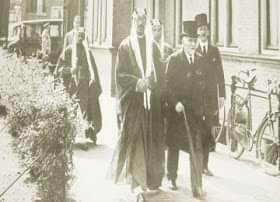Jewish conspiracy in Aceh
Learning Islam in Mecca, Snouck Hurgronje Pretending to Be a convert?
Snouck Hurgronje. The name is no stranger to the history of the nation's struggle Acheh, Thanks to information supplied by orientalists who mastered Acèh and Islamic culture, Dutch colonial forces succeeded in mastering Acèh.
Apparently, the progress of the Dutch people was not only recorded on the earth of the Veranda of Mecca. The Hurgronje footprint (1857-1936) also arrived in the real Makkah in Saudi Arabia. For the sake of studying Islam, the Hajj ritual, and the life of the people in Makkah, graduates of theology department at Lieden University, this had lived for about seven months in the Holy City.
The man who was born in Oosterhout, Netherlands, in 1857 and has the full name of Christiaan Snouck Hurgronje, this is even rumored to change his religious beliefs or become converts to be able to settle in the city of Makkah. All that was done so that he could learn Islam directly in his heart.
Today, photos of Hurgronje's work in Mecca are being exhibited at the Dubai Financial Center with the title 'Makkah, A Dangerous Adventure'. '' He was fascinated by various kinds of religions, but specifically he was interested in the teachings and systems of Islamic belief. He is also fluent in Arabic, '' said Elie Domit, a gallery curator.
In 1880, Hurgronje wrote his doctoral thesis entitled "Het Mekkansche Feest" (feast of Mecca) which described the Hajj and its customs. At that time, governments in European countries began to see the support provided by Muslim populations for independence efforts for the European and Dutch colonies. Makkah is seen as a gathering place for fanatical Muslim fighters.
In 1884, thanks to being funded by the Dutch government, Hurgronje was sent to Jeddah to examine the fanatical Muslim life in Mecca. But he also had a personal interest in entering the Holy Land. Because he was not a Muslim, he first left for Jeddah with the intention of approaching the elite there.
In order to be able to enter Makkah and gain the trust of residents and government officials there, Hurgronje publicly announced his decision to become a Muslim. Even then he was known as Abd Al-Ghaffar. Thanks to this method, he was finally allowed to enter Makkah and his journey was arranged on January 21, 1885.
For seven months, Hurgronje lived in Makkah. Although fairly short, he observed, noted, and studied the lives of local people. "At that time, Makkah had one of the largest slave markets in the world, and Hurgronje was amazed by the humane treatment given to slaves because the slaves were treated as family members," said Domit.
Hurgronje also observed the lives of women in Mecca. The issue of social status, sense of fashion, and freedom given to these women is compared to women in other cities in the East.
His great interest in Makkah was suspicious of other European governments. After that it was revealed that Hurgronje was a spy, a fraudster, as well as a little from the orientalists at the time. Shortly after marrying an Ethiopian woman, she was deported from Saudi Arabia at the request of the French government which accused her of stealing Taima stone.
As a result, Hurgronje must immediately leave Makkah. In a hurry, he collected notes and photographs he had obtained while living in Makkah. But the camera equipment was left behind and deposited with his friend, a photography student, Al-Sayyid Abd Al-Ghaffar.
Hurgronje then returned to the Netherlands and began writing various articles about Mecca. He kept in contact with his friend, Al-Sayyid to exchange information and get the latest photos about Makkah, including photographs of the pilgrims.
Upon returning to his homeland, no further news was known, whether he still held his Islamic religion, or returned to his native religion. However, many of the works he made about Islam and the culture of Mecca. Maybe because of that, his relationship with Saudi Arabian officials can be well established. As a sign of the close relationship, Prince Saud of the Kingdom of Saudi Arabia visited the Netherlands three times during the period 1926-1935.